目录
- 一. SpringSecurity简介
- 1. SpringSecurity概述
- 2. SpringSecurity的特征
- 二. SpringBoot整合SpringSecurity实现步骤
- 1. 需求分析
- 2. 创建web项目
- 3. 测试未添加SpringSecurity时的情况
- 4. 创建入口类
- 5. 访问接口
- 6. 添加Spring Security依赖包
- 7. 重启项目测试
- 8. 修改登录表单的用户名和密码
- 三. 基于HttpBasic认证
- 1. HttpBasic认证实现
- HttpBasic登录效果
- 2. HttpBasic基本原理
- 四. SpringBoot集成SpringSecurity实现权限管理
- 1. 创建实体类
- 1.1 创建Admin实体类
- 1.2 创建Member实体类
- 2. 继承WebSecurityConfigurerAdapter配置角色权限
- 3. 创建UserDetailsService
- 4. 创建controller层代码
- 4.1 创建AdminController
- 4.2 创建MemberController
- 5. 进行测试
- 5.1 member身份的权限,只能访问member相关的接口:
- 5.2 admin身份的权限,可以访问admin与member相关的接口:
- 结语
一. SpringSecurity简介
1. SpringSecurity概述
Spring Security 是 Spring 社区的一个顶级项目,也是 Spring Boot 官方推荐使用的安全框架。
除了常规的认证(Authentication)和授权(Authorization)之外,Spring Security还提供了诸如ACLs,LDAP,JAAS,CAS等高级特性以满足复杂场景下的安全需求。
另外,就目前而言,Spring Security和Shiro也是当前广大应用使用比较广泛的两个安全框架。
Spring Security 应用级别的安全主要包含两个主要部分,即登录认证(Authentication)和访问授权(Authorization),首先用户登录的时候传入登录信息,登录验证器完成登录认证并将登录认证好的信息存储到请求上下文,然后再进行其他操作,如在进行接口访问、方法调用时,权限认证器从上下文中获取登录认证信息,然后根据认证信息获取权限信息,通过权限信息和特定的授权策略决定是否授权。
2. SpringSecurity的特征
- 对身份验证和授权的全面和可扩展的支持;
- 防止会话固定,点击劫持,跨站点请求伪造等攻击;
- Servlet API集成;
- 可选与Spring Web MVC集成。
二. SpringBoot整合SpringSecurity实现步骤
1. 需求分析
当用户来访问接口时,根据用户携带的Authorization去查询此用户的角色,再根据设置好的角色所具有的权限进行判断,如果访问的接口是该角色下的接口,则进行接口放行。
2. 创建web项目
我们按照之前的经验,创建一个web程序,并将之改造成Spring Boot项目,具体过程略。
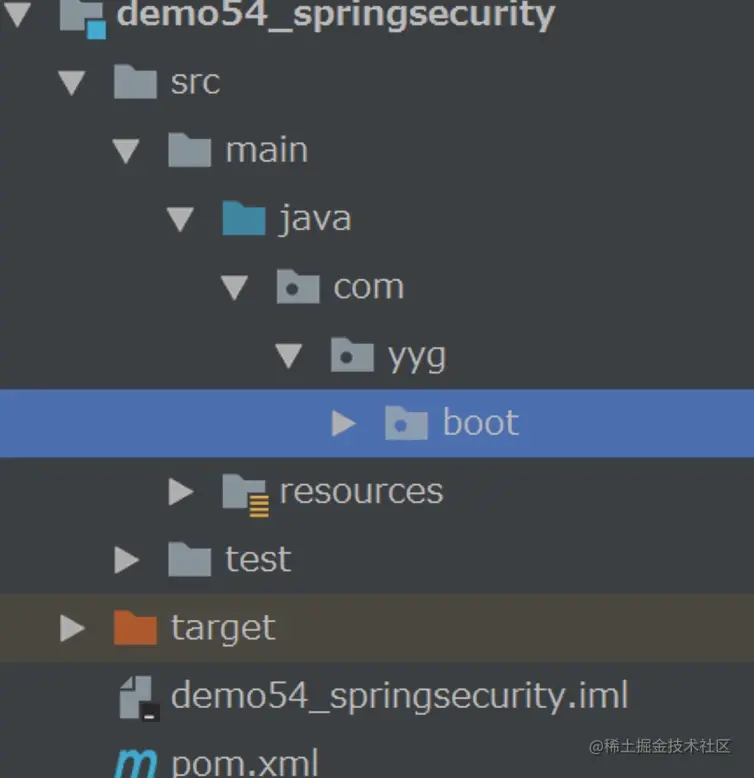
3. 测试未添加SpringSecurity时的情况
我们可以先测试一下项目中不添加Spring Security依赖包的情况,在这种情况下,我直接创建一个Controller接口,然后启动项目进行测试。
package com.yyg.boot.web;
import org.springframework.web.bind.annotation.GetMapping;
import org.springframework.web.bind.annotation.RestController;
/**
* @Author
* @Date Created in 2020/5/18
* @Description Description
*/
@RestController
public class IndexController {
@GetMapping("/hello")
public String hello() {
return "Hello SpringSecurity!";
}
}
4. 创建入口类
package com.yyg.boot;
import org.springframework.boot.SpringApplication;
import org.springframework.boot.autoconfigure.SpringBootApplication;
/**
* @Author 一一哥Sun
* @Date Created in 2020/5/18
* @Description Description
*/
@SpringBootApplication
public class SecurityApplication {
public static void main(String[] args){
SpringApplication.run(SecurityApplication.class,args);
}
}
5. 访问接口
此时我们可以看到,在浏览器中可以直接访问这个接口方法。

6. 添加Spring Security依赖包
<dependency>
<groupId>org.springframework.boot</groupId>
<artifactId>spring-boot-starter-security</artifactId>
</dependency>
7. 重启项目测试
当添加了spring-boot-starter-security依赖包之后,我们此时再重新启动项目进行测试。此时会发现控制台中有一行日志信息:也就是Spring Boot会自动产生一个随机的密码。

然后我们再访问刚才的接口,会发现接口会自动重定向到login登录页面。
然后在这个登录页面中,我们可以输入用户名和密码:
- 用户名:user
- 密码:控制台的随机密码
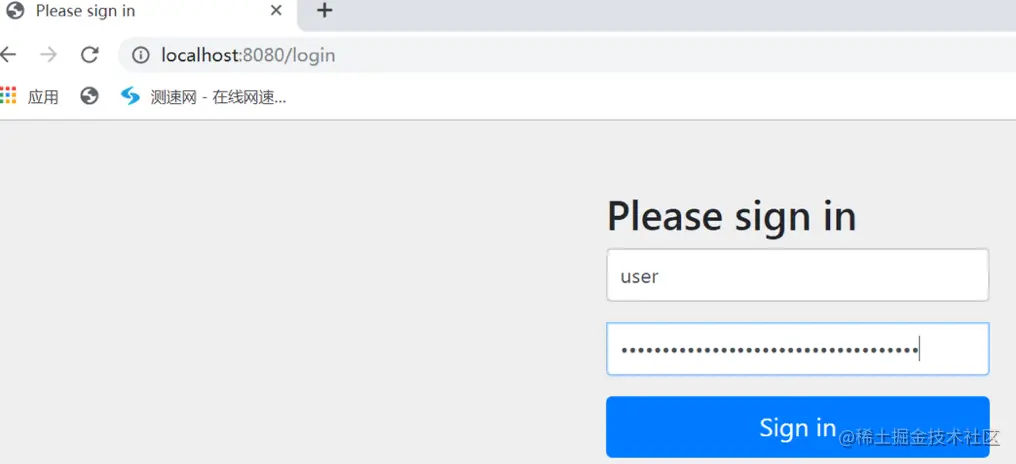
然后此时才可以看到刚才的接口内容。
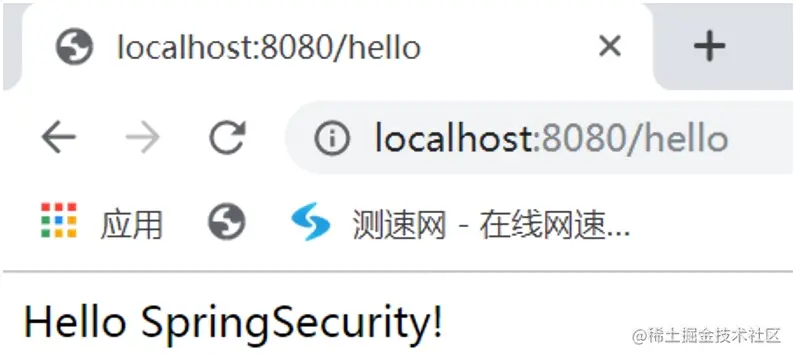
这是因为当Spring项目中引入了Spring Security依赖的时候,项目会默认开启如下配置:
security.basic.enabled=true
这个配置开启了一个表单认证,所有服务的访问都必须先过这个认证,默认的用户名为user,密码由Sping Security自动生成,回到IDE的控制台,可以找到密码信息:
Using generated security password: 078db2a5-ae07-4a10-a85c-cf0162a7e966
8. 修改登录表单的用户名和密码
我们可以在application.yml文件中,通过spring.security属性进行用户名和密码的配置。
server:
port: 8080
spring:
security:
user:
name: admin
password: 123
此时可以看到,新的登录名和密码变成了我们设置好的。

三. 基于HttpBasic认证
1. HttpBasic认证实现
配置SpringSecurity认证方式。
创建一个配置类SpringSecurityConfig继承org.springframework.security.config.annotation.web.configuration.WebSecurityConfigurerAdapter这个抽象类并重写configure(HttpSecurity http)方法。
WebSecurityConfigurerAdapter是由Spring Security提供的Web应用安全配置的适配器:
@Configuration
public class SpringSecurityConfig extends WebSecurityConfigurerAdapter {
@Override
protected void configure(HttpSecurity http) throws Exception {
http.httpBasic() // HttpBasic
// http.formLogin() // 表单方式
.and()
.authorizeRequests() // 授权配置
.anyRequest() // 所有请求
.authenticated(); // 都需要认证
}
}
HttpBasic登录效果
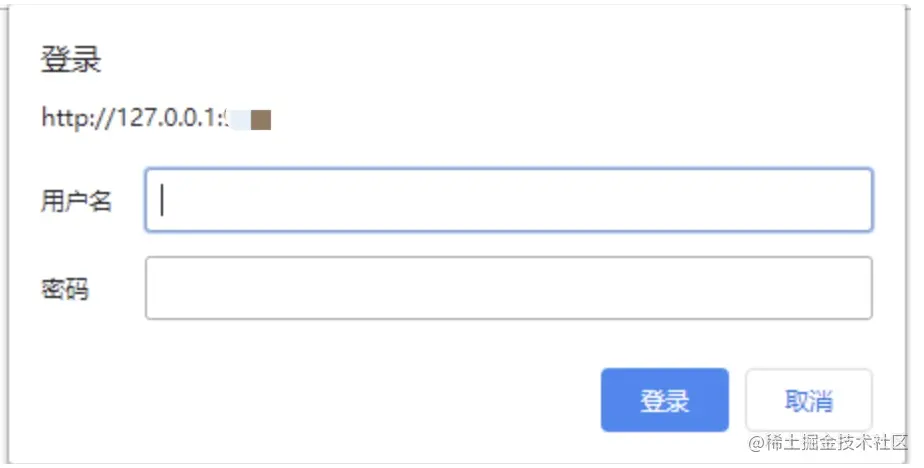
2. HttpBasic基本原理
上面我们开启了一个最简单的Spring Security安全配置,下面我们来了解下Spring Security的基本原理。通过上面的的配置,代码的执行过程可以简化为下图表示:
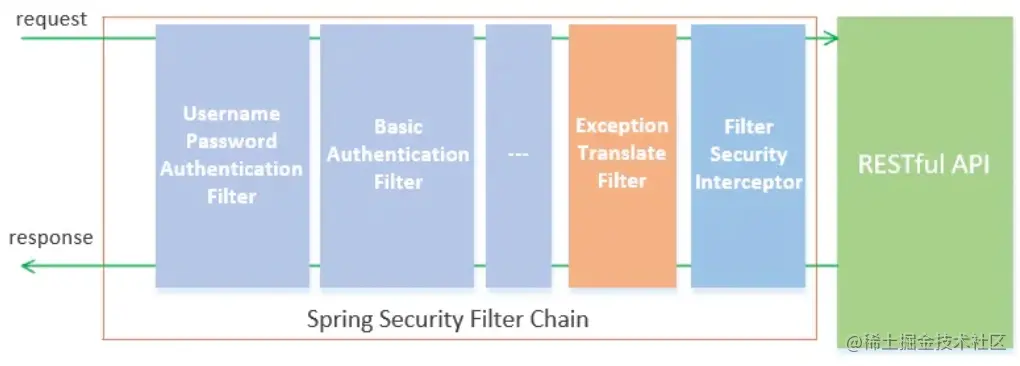
如上图所示,Spring Security包含了众多的过滤器,这些过滤器形成了一条链,所有请求都必须通过这些过滤器后才能成功访问到资源。
其中UsernamePasswordAuthenticationFilter过滤器用于处理基于表单方式的登录认证,而BasicAuthenticationFilter用于处理基于HTTP Basic方式的登录验证,后面还可能包含一系列别的过滤器(可以通过相应配置开启)。
在过滤器链的末尾是一个名为FilterSecurityInterceptor的拦截器,用于判断当前请求身份认证是否成功,是否有相应的权限,当身份认证失败或者权限不足的时候便会抛出相应的异常。ExceptionTranslateFilter捕获并处理,所以我们在ExceptionTranslateFilter过滤器用于处理了FilterSecurityInterceptor抛出的异常并进行处理,比如需要身份认证时将请求重定向到相应的认证页面,当认证失败或者权限不足时返回相应的提示信息。
四. SpringBoot集成SpringSecurity实现权限管理
我们在上面案例的基础上,进行本案例的开发讲解。
1. 创建实体类
1.1 创建Admin实体类
package com.yyg.boot.domain;
import lombok.Data;
import java.io.Serializable;
/**
* @Author 一一哥Sun
* @Date Created in 2020/5/18
* @Description Description
*/
@Data
public class Admin implements Serializable {
private String username;
private String password;
}
1.2 创建Member实体类
package com.yyg.boot.domain;
import lombok.Data;
import java.io.Serializable;
/**
* @Author 一一哥Sun
* @Date Created in 2020/5/18
* @Description Description
*/
@Data
public class Member implements Serializable {
private String id;
private String username;
private String password;
}
2. 继承WebSecurityConfigurerAdapter配置角色权限
package com.yyg.boot.config;
import org.springframework.beans.factory.annotation.Autowired;
import org.springframework.context.annotation.Bean;
import org.springframework.context.annotation.Configuration;
import org.springframework.security.config.annotation.authentication.builders.AuthenticationManagerBuilder;
import org.springframework.security.config.annotation.web.builders.HttpSecurity;
import org.springframework.security.config.annotation.web.builders.WebSecurity;
import org.springframework.security.config.annotation.web.configuration.WebSecurityConfigurerAdapter;
import org.springframework.security.core.userdetails.UserDetailsService;
import org.springframework.security.crypto.bcrypt.BCryptPasswordEncoder;
import org.springframework.security.crypto.password.PasswordEncoder;
/**
* @Author 一一哥Sun
* @Date Created in 2020/5/18
* @Description Description
*/
@Configuration
public class SpringSecurityConfig extends WebSecurityConfigurerAdapter {
//@Override
//protected void configure(HttpSecurity http) throws Exception {
//http.httpBasic() // 简单的HttpBasic登录方式
//http.formLogin() // 提供一个登录的表单
//.and()
//.authorizeRequests() // 授权配置
//.anyRequest() // 所有请求
//.authenticated(); // 都需要认证
//}
@Autowired
private UserDetailsService userDetailsService;
@Bean
public PasswordEncoder passwordEncoder() {
return new BCryptPasswordEncoder();
}
@Override
public void configure(WebSecurity web) throws Exception {
super.configure(web);
}
//内存方式创建用户
// @Override
// public void configure(AuthenticationManagerBuilder auth) throws Exception {
// auth.inMemoryAuthentication()
// .withUser("admin").password("123456").roles("ADMIN")
// .and()
// .withUser("member").password("123456").roles("MEMBER");
// }
@Override
public void configure(AuthenticationManagerBuilder auth) throws Exception {
auth.userDetailsService(userDetailsService)
//passwordEncoder是对密码的加密处理,如果user中密码没有加密,则可以不加此方法。注意加密请使用security自带的加密方式。
.passwordEncoder(passwordEncoder());
}
@Override
protected void configure(HttpSecurity http) throws Exception {
http.csrf()
//禁用了 csrf 功能
.disable()
//限定签名成功的请求
.authorizeRequests()
.antMatchers("/employee/*")
//对employee 下的接口,需要 MEMBER 或者 ADMIN 权限
.hasAnyRole("MEMBER","ADMIN")
//对employee/login接口直接放行,不限制
.antMatchers("/employee/login")
.permitAll()
//对admin下的接口 需要ADMIN权限
.antMatchers("/admin/**")
.hasRole("ADMIN")
//不拦截 oauth 开放的资源
.antMatchers("/oauth/**")
.permitAll()
//其他没有限定的请求,允许访问
.anyRequest()
.permitAll()
.and()
//对于没有配置权限的其他请求允许匿名访问
.anonymous()
.and()
//使用 spring security 默认登录页面
.formLogin()
.and()
//启用http 基础验证
.httpBasic();
}
}
3. 创建UserDetailsService
package com.yyg.boot.service;
import com.yyg.boot.domain.Admin;
import com.yyg.boot.domain.Member;
import org.springframework.security.core.GrantedAuthority;
import org.springframework.security.core.authority.SimpleGrantedAuthority;
import org.springframework.security.core.userdetails.User;
import org.springframework.security.core.userdetails.UserDetails;
import org.springframework.security.core.userdetails.UserDetailsService;
import org.springframework.security.core.userdetails.UsernameNotFoundException;
import org.springframework.security.crypto.bcrypt.BCryptPasswordEncoder;
import org.springframework.stereotype.Service;
import java.util.ArrayList;
import java.util.List;
/**
* @Author
* @Date Created in 2020/5/18
* @Description Description
*/
@Service
public class UserDetailServiceImpl implements UserDetailsService {
@Override
public UserDetails loadUserByUsername(String username) throws UsernameNotFoundException {
List<GrantedAuthority> grantedAuthorities = new ArrayList<>();
//生成环境是查询数据库获取username的角色用于后续权限判断(如:张三 admin)
//这里不做数据库操作,给定假数据,进行简单模拟.
if ("member".equals(username)) {
Member member = new Member();
member.setUsername("member");
member.setPassword("123456");
GrantedAuthority grantedAuthority = new SimpleGrantedAuthority("ROLE_MEMBER");
grantedAuthorities.add(grantedAuthority);
//创建一个用户,用于判断权限,请注意此用户名和方法参数中的username一致;BCryptPasswordEncoder是用来演示加密使用。
return new User(member.getUsername(), new BCryptPasswordEncoder().encode(member.getPassword()), grantedAuthorities);
}
if ("admin".equals(username)) {
Admin admin = new Admin();
admin.setUsername("admin");
admin.setPassword("123456");
GrantedAuthority grantedAuthority = new SimpleGrantedAuthority("ROLE_ADMIN");
grantedAuthorities.add(grantedAuthority);
return new User(admin.getUsername(), new BCryptPasswordEncoder().encode(admin.getPassword()), grantedAuthorities);
} else {
return null;
}
}
}
4. 创建controller层代码
4.1 创建AdminController
package com.yyg.boot.web;
import org.springframework.web.bind.annotation.GetMapping;
import org.springframework.web.bind.annotation.RequestMapping;
import org.springframework.web.bind.annotation.RestController;
/**
* @Author 一一哥Sun
* @Date Created in 2020/5/18
* @Description Description
*/
@RestController
@RequestMapping("/admin")
public class AdminController {
@GetMapping("/greeting")
public String greeting() {
return "Hello,Admin!";
}
@GetMapping("/login")
public String login() {
return "login success!";
}
}
4.2 创建MemberController
package com.yyg.boot.web;
import org.springframework.web.bind.annotation.GetMapping;
import org.springframework.web.bind.annotation.RequestMapping;
import org.springframework.web.bind.annotation.RestController;
/**
* @Author 一一哥Sun
* @Date Created in 2020/5/18
* @Description Description
*/
@RestController
@RequestMapping("/member")
public class MemberController {
@GetMapping("/greeting")
public String greeting() {
return "Hello,Member!";
}
@GetMapping("/login")
public String login() {
return "login success!";
}
}
5. 进行测试
此时我们可以利用postman,通过Basic认证方式,携带用户名和密码进行相关接口的访问。
5.1 member身份的权限,只能访问member相关的接口:
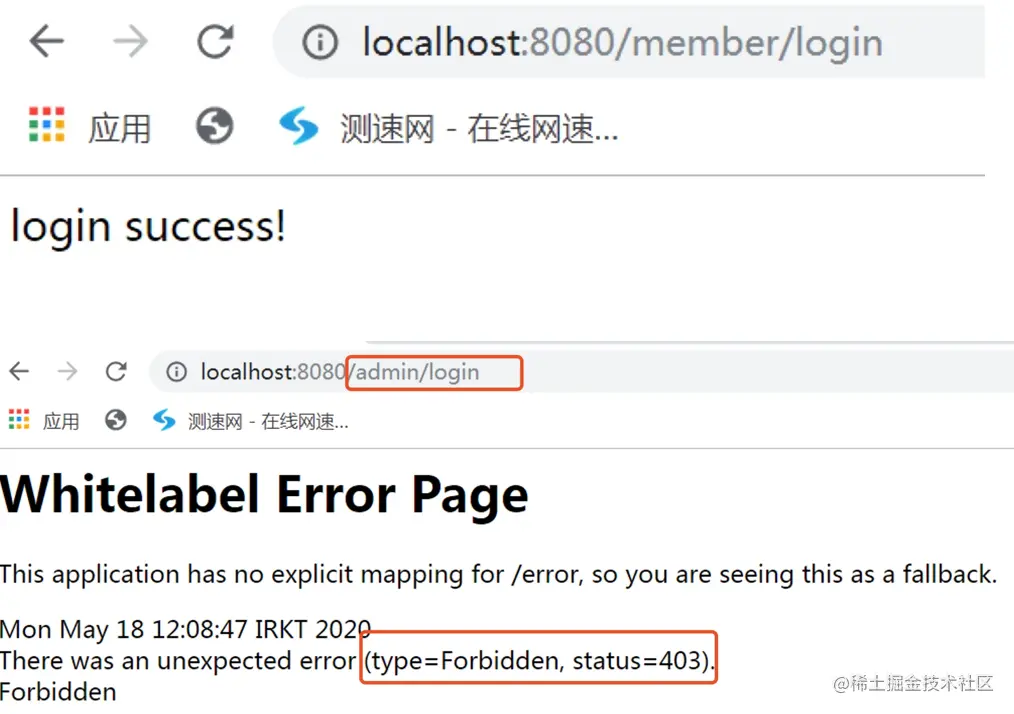
5.2 admin身份的权限,可以访问admin与member相关的接口:
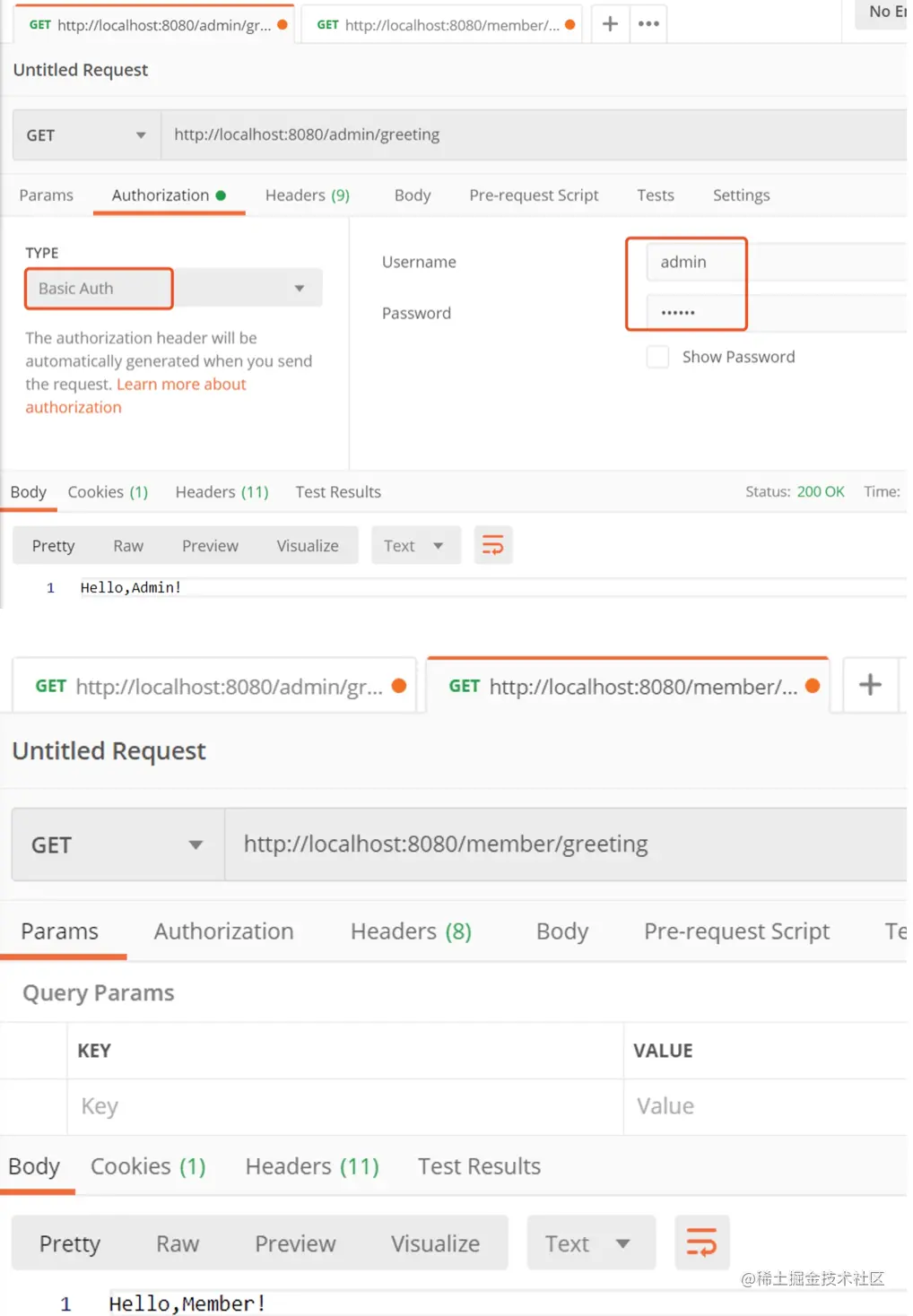
后续我们可以关联数据库,从数据库中查询用户的身份和角色信息,从而进一步给用户分配权限信息。
结语
至此,我们就对Web项目添加了一个安全防护,而且实现起来简直不要太easy!现在你知道该怎么保护自己的Web项目不被“伤害”了吗?
以上就是SpringBoot整合SpringSecurity实现认证拦截的教程的详细内容,更多关于SpringBoot整合SpringSecurity实现认证拦截的资料请关注自由互联其它相关文章!
